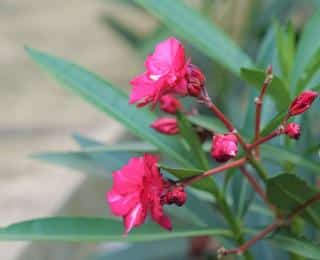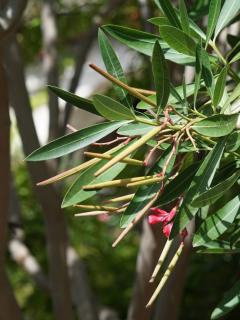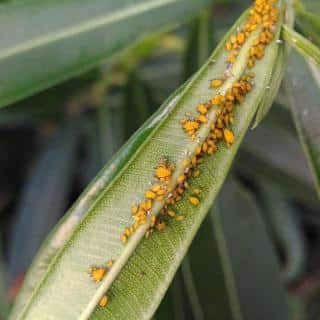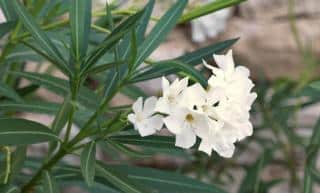

Oleander is a beautiful shrub that blooms all summer long.
Summary of key Oleander facts
Name – Nerium oleander
Family – Apocynceae or dogbane
Type – shrub, bay
Height – 3 to 10 feet (1 to 3 m)
Exposure – full sun
Soil – ordinary, well drained
Foliage – evergreen
Flowering – from June to September
Pruning, caring for and watering oleander helps increase flowering, growth and avoid diseases. Take note, though, that this beauty comes at a price. The entire plant is highly toxic, and ingesting a single leaf can be fatal even to adults. In some places it’s also considered invasive.
Oleander planting, when done correctly, ensures that it sets in and develops well. Planting is a critical step.
Preferably done in fall or spring, planting oleander is an important step because it guarantees that the shrub will develop correctly.

Adding tomato or vegetable fertilizer is a particularly effective trick to produce abundant flowers all summer long.
Planting oleander in pots or garden boxes is perfectly possible and even recommended in regions where it freezes in the winter.

More so than with oleander planted in the ground, soil mix in pots quickly loses its nutritional value. Adding tomato fertilizer is a definite “plus” to continue producing abundant flowers.
Making cuttings is the easiest and fastest technique to propagate oleander.
Traditionally, oleander cuttings are most successful in August but it is perfectly possible to start a bit earlier, in June or July.

But take note that oleander flowers only on wood stems from the previous year, so it’s better to not prune it all at once since this would lead to a year without flowers.
The idea is to prune ⅓ of the branches every year (as in, “one in three”), so that you cover the entire bush within three years.
As for regular care, oleander can get by with very little care once it is comfortably settled in.
At the very beginning of spring,
After flowering and before bringing your potted oleander in for the winter, cut back ⅓ of the branches to half their length to maintain a nice, tight silhouette.
Every year, proceed to pruning again another third of the branches so that the whole of the shrub is pruned over a three-year cycle.
If you live in a zone where there is little or no freezing, you can leave oleander outdoors without any manner of protection.
But if it freezes in your zone, protect your oleander with a winterizing cover.
In most cases, it is either a water supply problem or a problem related to freezing.

Correct watering and adding a good dose of fertilizer is often enough to strengthen it and let it fight back the diseases.
Regularly applying Bordeaux mixture acts as a deterrent against most types of fungus such as leaf spot septoriosis due to Septoria nerii.
This shrub produces beautiful white or pink flowers all summer long. Its long leaves are typical of Mediterranean plant flora.

In summer, water in abundance during heat waves, especially for oleander in pots.
Easy to care for and to grow, oleander is without doubt one of the most beautiful summer-flowering shrubs.
Trigger massive flower-bearing with fertilizer suited to tomatoes and vegetables.
Read also:
When watering in the summer, choose to water in the evening to avoid evaporation.
Watch out for the plant’s toxicity: coming in hand or mouth contact with the plant is dangerous for health. Wear gloves and teach children not to play with it.
Just found very useful information about my standard oleander, bought it last spring didn’t know much about it and it got huge in summer
Oleander does grow prolifically when in the proper growing environment. And the blooms are very beautiful!